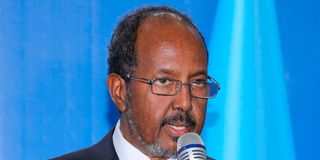Premium
Somalia in EAC? Behold ‘the End of History’ in the Greater Horn

Somalia President Hassan Sheikh Mohamud. Somalia's entry into EAC brings to a blissful close the age of explosive and competing ideologies.
On November 24, 2023, East African Community (EAC) leaders, sitting in Arusha, Tanzania, endorsed Somalia as the eighth member of the group.
The spotlight has been on the economic impact of Somalia’s entry into one of Africa’s most successful and rapidly expanding regional blocs. However, the ideological significance of this watershed moment should not be lost.
Somalia’s integration into the EAC carries almost the same impact on the future of the Horn of Africa as the seismic ideological changes American political scientist Francis Fukuyama describes in his 1992 book, The End of History and the Last Man.
With dissolution of the Soviet Union (1991), Fukuyama argued, humanity had reached the end of history — end-point of mankind's ideological evolution and universalisation of Western liberal democracy.
Criticism to Fukuyama’s thesis aside, the geopolitics of the Horn have seen an explosive three-way ideological competition for dominance involving Pan-Somalism, Pan-Ethiopianism and pan-Africanism.
It’s entry into EAC marks ‘the end of history in the Horn’: it has sounded the death knell for Pan-Somalism, signaled the quiet triumph of Pan-Africanism but raised serious questions about the future of pan-Ethiopianism.
The explosive ideological competition for dominance in the Horn involving pan-Somalism, pan-Ethiopianism and Pan-Africanism has unfolded over three phases. The first phase is the age of war saw the rise of Pan-Ethiopianism, Pan-Somalism and modern pan-Africanism as competing ideologies in the Horn.
At independence in July 1960, Somalia began to push for restoration its “lost lands” and unification of “all Somali peoples” into ‘the Greater Somalia’. The doctrine of “Greater Somalia” became the primary driver of Somali nationalism or Pan-Somalism and defined Somalia’s priority in foreign policy. As a major cause of tensions and even wars between Somalia and its neighbours — Ethiopia, Kenya, and Djibouti — pan-Somalism signified an irredentist threat and source of instability in the Horn.
It has been said that Somalia is a nation in search of a state. This is a contrast to the ideology of pan-Africanism, the creation of a nation out of many ethnic nations in a single state inherited by colonialism and further unification of these states into a single consciousness or United States of Africa . In this respect, Pan-Somalism is incompatible with Pan-Africanism.
Pan-Somalism failed to attain diplomatic support or battleground victory, neglected the domestic economy to stoke regional conflicts. It met its first waterloo on October 23, 1967 following Kenya’s victory in the Shifta War (1963-1967). The March 23, 1978 Ethiopian victory in the Ogaden War signified the triumph of pan-Ethiopianism over pan-Somalism. Somalia’s long walk to pan-Africanism had begun.
The second encounter is the age of terror characterised by the al-Shabaab Islamist insurgency. The youth militia rode to prominence on the tidal wave of pan-Somali nationalism against the ‘Ethiopian invasion’ of Somalia in 2006. Kenya sent troops into Somalia to degrade the al Qaeda–affiliate, fighting alongside Uganda, Ethiopia, Burundi and Djibouti.
The third phase is the resurgence of Pan-Somali nationalism after Mohamed Abdullahi Mohamed (“Farmaajo”) came to power. When Abiy Ahmed Ali, an Oromo, became Prime Minister of Ethiopia in 2018, pan-Somalism met Pan-Ethiopianism in the ‘Cushitic consciousness’ used to unite the Oromo and Somali to isolate Kenya.
The ensuing clash between pan-Africanism and Cushitic alliance saw the rise of the Horn of Africa Alliance that effectively challenged and weakened the Inter-Governmental Authority on Development (IGAD).
The fourth phase is the age of peace following the election of Hassan Sheikh Mohamud in May 2022. Political changes inside Somalia revitalised IGAD as the cornerstone of peace and security architecture in the Horn and paved the way for Somalia’s integration into the EAC.
The integration of Somalia, stretches EAC from the Atlantic through the Indian Ocean up to the Gulf of Aden. It has added 3,330 km long Somali coastline, the longest in Africa stretching along the Gulf of Aden to the north and the Indian Ocean to the east and south, increasing the bloc’s coastline to almost 5,000 km.
Somalia brings to EAC a vibrant market economy, a young generation, a strong entrepreneurial class and business-oriented society with substantial investment in Africa and Middle East and huge natural resources. With EAC citizens exempted from visa requirements, Somali entrepreneurs can now travel freely and invest across the 5.45 million km2 region larger than the European Union.
Somalia will benefit from the EAC’s roads, railways, and energy networks. EAC might also become attractive to the breakaway Somaliland, and unite Somalia.
Pan-Africanism in the Horn is rising. The EAC bloc plans to bring in all the countries of the greater Horn of Africa by 2025, expanding the market to over 800 million people. After Somalia, EAC is eyeing the Horn of African countries of Ethiopia, Djibouti, Eritrea and even the troubled Sudan to join the bloc. Pan-Africanism, Pan-Ethiopianism and pan-Somalism — could exist under one bloc.
- Prof Peter Kagwanja former Government Adviser (2008-2013), and currently Chief Executive at the Africa Institute, Adjunct Professor at the University of Nairobi and the National Defence University — Kenya.





